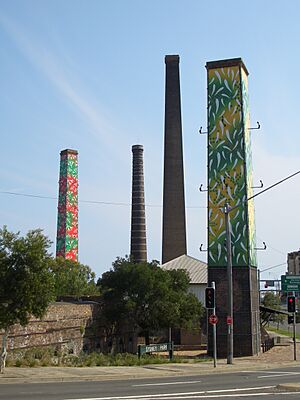Sydney Park facts for kids
Quick facts for kids Sydney Park |
|
|---|---|

Former Austral brick works at Sydney Park
|
|
| Location | Princes Highway, St Peters (), Sydney, New South Wales, Australia |
| Area | 41.6 hectares (103 acres) |
| Created | 11 February 1991 |
| Operated by | Sydney City Council |
| Open | 24 hours |
| Status | Open all year |
| Public transit access |
|
|
Invalid designation
|
|
| Official name: Former Bedford Brickworks Group Including Chimneys, Kilns and Grounds; Austral Brickworks | |
| Type: | Local government (built) |
| Criteria: | a., b., c., d., e., g. |
| Designated: | 14 December 2012 |
| Reference #: | I27 |
| Group: | Manufacturing and Processing |
| Category: | Industrial Office/Admin Building |
Sydney Park is a large green space in Sydney, Australia. It covers about 41.6 hectares (103 acres). The park is located in the inner-city area, near the suburbs of Alexandria, Newtown, and Erskineville.
It is the third largest park in inner-city Sydney. Sydney Park has big open areas with unique hills that offer amazing 360-degree views of the city. You can also find a children's playground, wetlands, a sports oval, a bike track for kids, and interesting sculptures. Part of the park still has old brickworks buildings, which are important historical sites.
Some parts of the park and its trees might be removed. This is because of a big transport project called WestConnex.
Contents
Park History
Before European settlers arrived, the land where Sydney Park now stands was very different. The north-western part was a forest with turpentine and ironbark trees. The south-eastern part was a swampy area with heathland. This swamp was connected to a waterway called Shea's Creek.
The first person to clear the woodland was Thomas Smyth. He was a marine sergeant with the First Fleet. He planted fruit trees and grew crops on the land.
Brick Making and Industry
The north-west part of the park sits on a special type of clay called Wianamatta shale. This clay was perfect for making bricks. By the 1870s, brick making was a huge industry here. Machines were brought in to make bricks faster.
The bricks made at this site were used all over Sydney for more than 100 years. The first machine-made bricks helped build the Farmers’ Building in Sydney. Josiah Gentle opened the Bedford Brickworks in 1893. Later, in 1933, Austral Bricks took over the site. They ran the brickworks until 1970.
Other parts of the land were used for different industrial activities. These included manufacturing, storage, and even gas storage. The old brickworks buildings are now protected as important historical sites.
From Tip to Park
After the brickworks closed, the huge clay pits were used for something else. From 1948 to 1976, they became a city waste dump. After the dump closed, the area was cleaned up. Layers of soil and building materials were placed over the old rubbish. This created the hills and shape of the park we see today.
Art and Heritage Features
Sydney Park has several interesting public artworks. One example is "The Trail" by Michael Snape, created in 1990. You can find it on top of a hill in the park's north-western corner. This corner is across from St Peters railway station.
This area also features the old chimneys and kilns from the former brickworks. These tall chimneys are very noticeable. They have been kept as important heritage items.
Sports and Fun Activities
The Alan Davidson Oval is located in the northern part of Sydney Park. This oval is used for sports like cricket and Australian rules football. It is the home ground for the South Sydney District Cricket Club. It also hosts the Newtown Swans Junior Australian rules football team.
The park is also home to the St Peters Parkrun. This is a free 5-kilometer run held every Saturday morning. People run along the park's bike trails and paths.
Community Events
Sydney Park has been a popular spot for community gatherings and events. In the past, it was used for informal youth events. Now, the City of Sydney Council supports community arts festivals here.
The park hosts Sydney's Earthdance event. This is a dance party that happens at the same time in many countries. It celebrates the International Day of Peace every September. The park has also hosted the touring Soundwave Festival in 2007 and 2008.
Plants and Animals
The park has been replanted with many native trees and shrubs. Stormwater ponds in the eastern part of the park have been turned into wetlands. These wetlands are like the original swampy areas that used to be here.
This has created a home for many different birds and animals. You can see dusky moorhens, Australian magpies, and pelicans. It has also become a place where black swans come to breed.
Images for kids








